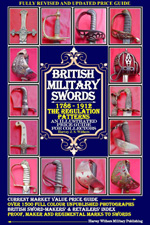This article is taken from my book – British Military Swords 1786-1912. An Illustrated Price Guide for Collectors. To order a copy please go HERE.
British Army Sword Markings – Government Issue Marks
Prior to 1788, there is very little evidence that other ranks’ swords went through a rigorous form of official inspection. Sword blades of that period are invariably unmarked, with the occasional maker’s name to blade edge or forte. Colonels of regiments were allocated a budget for the purchase of swords, and had total control over the choice of supplier and the pattern of sword to be issued. It is likely that they went for cheapness rather than quality.
This led to instances of blade failure and consequent loss of life. After 1788, the Board of General Officers recommended that a series of proofs or tests should be applied to new swords. When a sword passed its test and was declared suitable by a government approved viewer, view marks were applied to the blade. Initially, these were simple figures punched onto the blade, and comprised a crown above the digit.
The government manufactory at Enfield, London, began producing service swords after 1820, and many blades are marked either “ENFIELD” OR “EFD”, with the year of manufacture, e.g. (18)“44”, following. Pre -1855, swords purchased by the Board of Ordnance are marked with a broad arrow and “BO”. After this date, they are marked with a broad arrow and “WD”, (War Department).
Swords after 1855 have the pattern number stamped to the blade e.g. ‘/99 = 1899 Pattern Cavalry Trooper’s Sword. “X” indicated that the sword had undergone bending tests and those condemned as unfit for service were marked with two arrows facing eachother.
© British Military Sword Markings – Government Issue Marks article by Harvey Withers – www.militariahub.com
Not to be reproduced without prior agreement.



